
Opale etiope: storia, simbolismo, significati e altro ancora!
 Gli opali provengono da tutto il mondo, ma molte località minerarie producono esemplari unici e bellissimi, diversi da qualsiasi altro. In Africa, ad esempio, si trovano gli opali etiopi dai colori vivaci, spesso chiamati opali di Welo.
Gli opali provengono da tutto il mondo, ma molte località minerarie producono esemplari unici e bellissimi, diversi da qualsiasi altro. In Africa, ad esempio, si trovano gli opali etiopi dai colori vivaci, spesso chiamati opali di Welo.
Molti appassionati di opali conoscono l'Australia come la capitale mondiale degli opali . Gli opali etiopi sono autentici? Assolutamente sì!
Sebbene circa il 95% degli opali mondiali provenga da miniere australiane, le moderne scoperte di opali etiopi hanno collocato questa miniera africana subito dopo l'Australia in termini di produzione e qualità . Ancora più di recente, un opale nero etiope ha avuto un ruolo essenziale nel film del 2019 "Diamanti grezzi" !
Se sei alle prime armi con il mondo degli opali, potresti conoscere questa gemma solo come la tradizionale pietra portafortuna di ottobre . Forse hai sentito parlare della " maledizione dell'opale " o semplicemente conosci la pietra per i suoi colori caleidoscopici, ma c'è molto di più da imparare, in particolare sugli opali etiopi.
In questa guida scoprirai le proprietà fisiche e spirituali dell'opale etiope, insieme alla storia e al simbolismo dietro queste gemme fenomenali!

Cos'è l'opale etiope?
L'opale welo etiope è un tipo di opale relativamente nuovo, scoperto nelle regioni montuose dell'Etiopia settentrionale, in particolare nella provincia di Wollo.
Qual è la differenza tra opale e opale etiope? Tecnicamente nessuna, poiché gli opali etiopi sono pur sempre opali, con la stessa durezza minerale di 5,5-6,5 sulla scala di Mohs . Tuttavia, esistono molti tipi diversi di opali , le categorie principali sono quelle preziose e quelle comuni .
Gli opali preziosi sono caratterizzati dal loro gioco di colori , mentre gli opali comuni sono tutti gli opali senza giochi di colori. Gli opali etiopi sono apprezzati per il loro vivace gioco di colori, che si manifesta in numerose tonalità e motivi.
Una caratteristica distintiva è che la maggior parte degli opali etiopi sono idrofani , ovvero le loro superfici porose assorbono l'acqua, modificandone aspetto, dimensioni e stabilità quando immerse. Queste pietre sono opache o traslucide, come molti opali, ma l'opale etiope in acqua diventa trasparente!
Per quanto riguarda il colore , gli opali etiopi sono disponibili in diverse varietà, da colori solidi come il nero, il rosa o il blu a un arcobaleno di sfumature che si abbinano a vari toni del corpo .
Detto questo, quali sono le diverse varietà di opale etiope?
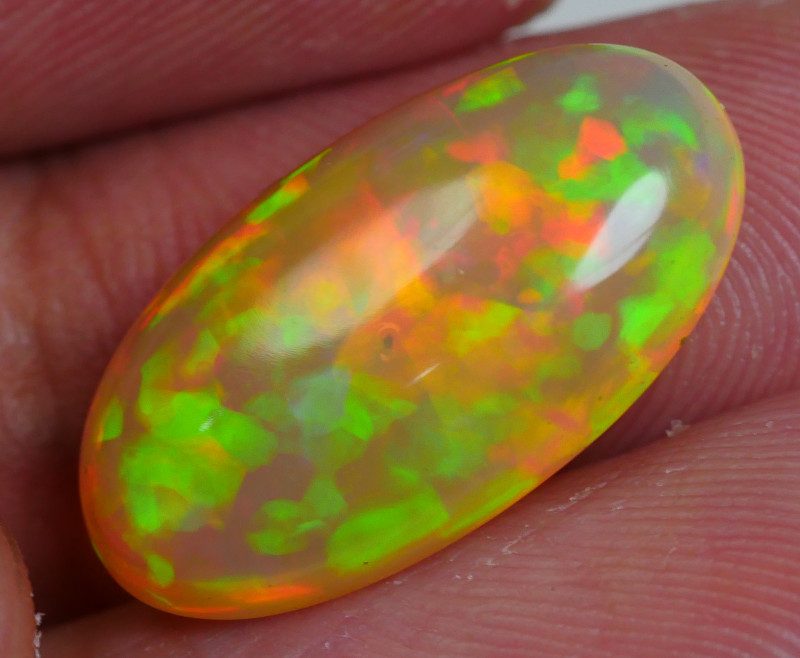
Tipi di opale etiope
Tutti gli opali etiopi presentano giochi di colore, ma la tonalità del corpo è diversa. I tre giacimenti principali (di cui parleremo più avanti) producono varietà distinte, tra cui:
Opale di fuoco prezioso: abbondanti opali traslucidi provenienti dalla provincia di Wollo, con il colore del corpo rosso, arancione o giallo tipico degli opali di fuoco e il gioco di colori tipico dell'opale prezioso, che spesso mostra vivaci lampi di colore viola e verde.
Opale nero: rari opali neri naturali che non sono idrofani, rinvenuti nella miniera Stayish nella provincia di Wollo, sebbene molti opali etiopi siano trattati per essere neri.
Opale Shewa o Mezezo: i primi esemplari etiopi sono stati scoperti nel 1994 nella provincia di Shewa, solitamente di colore bruno-rossastro, arancione o marrone cioccolato, ma presentano spesso problemi di screpolature , un tipo di danno in cui l'essiccazione provoca crepe simili a ragnatele.
Opale bianco prezioso: opali etiopi con corpo di colore bianco, gioco di colori brillante e stabilità molto migliore rispetto agli opali Shewa. Si trovano tipicamente nei pressi di Wegel Tena.
Questi esempi non coprono ogni tipo di opale etiope, poiché il numero di colori e motivi del corpo rivaleggia con quello degli opali australiani. A proposito, in cosa differiscono gli opali australiani ed etiopi?
Le principali differenze tra gli opali australiani e quelli etiopi sono che gli opali etiopi sono solitamente più grandi, più rari e meno costosi degli opali australiani.
Una differenza significativa tra gli opali australiani ed etiopi è il loro processo di formazione, di cui parleremo più avanti!
Proprietà della pietra preziosa opale etiope
A differenza dell'opale australiano che si forma in profondità nel sottosuolo, l'opale etiope si forma in alta montagna. L'attività vulcanica è alla base della formazione di questi opali idrofani, che si presentano con una forma a noduli (come sfere a forma di grumo) anziché a venature come la maggior parte degli opali.
Una volta estratti, è il momento di tagliare e valutare questi opali, ma come vengono classificati? Poiché la pietra è nuova nel settore, la classificazione dell'opale etiope è complessa e in qualche modo soggettiva, ma generalmente vengono classificati in base a motivo, luminosità, trattamenti e colore.
Modello
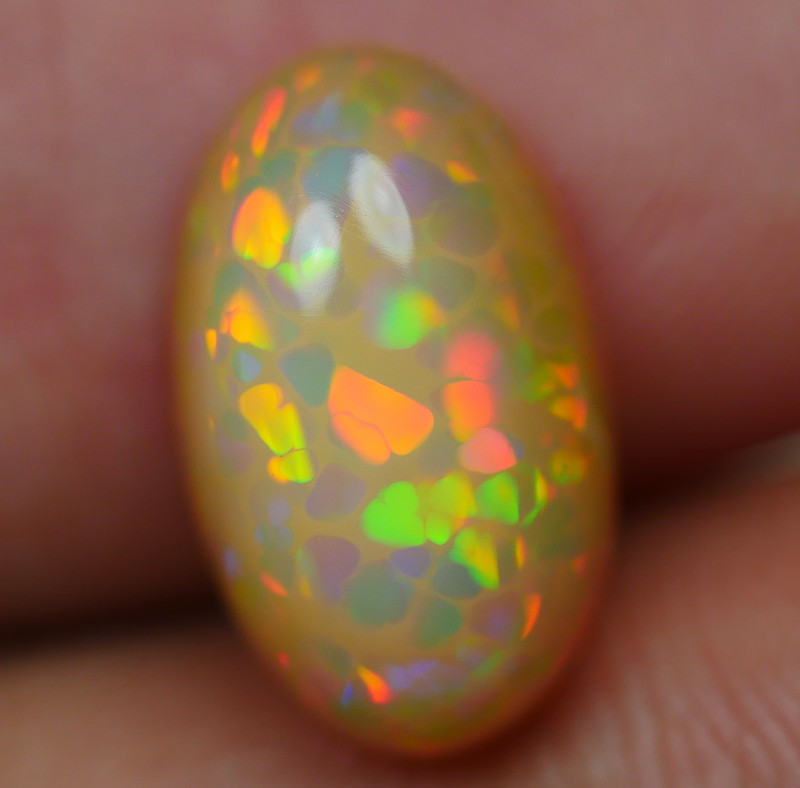
Gli opali etiopi sono unici per i loro motivi variegati e vivaci, che vanno dal Welo Broad Flash al Fire Cloud! Il motivo più ricercato è il nido d'ape, un motivo esclusivo dell'opale etiope in cui l'opale comune forma una linea con inclusioni a ragnatela attraverso la pietra. Le pietre con motivi a nido d'ape sono tipicamente tagliate a cabochon .
Luminosità
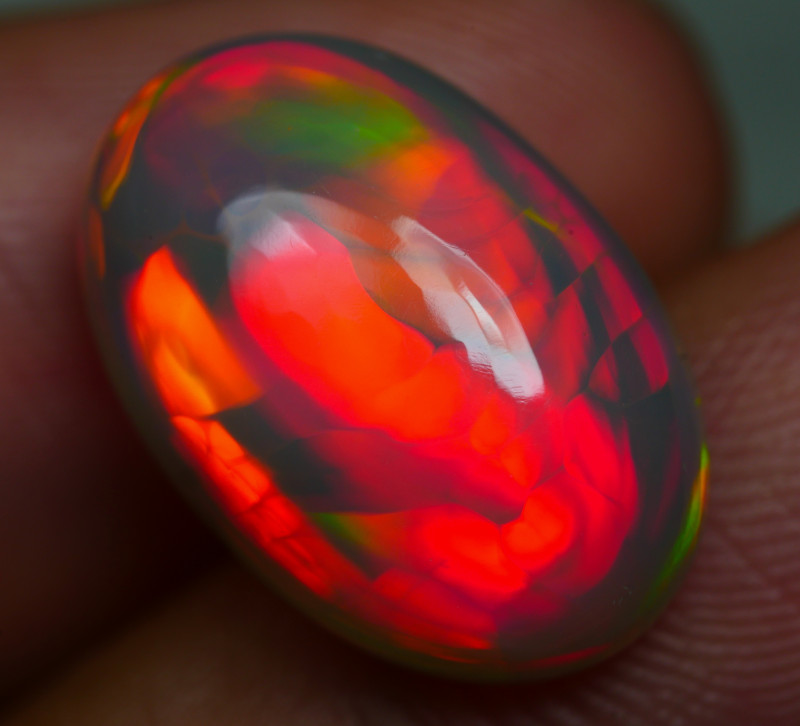
La luminosità si riferisce al "fuoco" di una pietra, ovvero ai bagliori colorati causati dalla dispersione della luce. Il fuoco presente in molti opali etiopi mostra un raro effetto tridimensionale. Per quanto riguarda il colore, i bagliori di colore blu e verde sono tipici, sebbene possano verificarsi anche rari bagliori rossi. In generale, le pietre con un fuoco più luminoso e saturo hanno prezzi più elevati.
Trattamenti
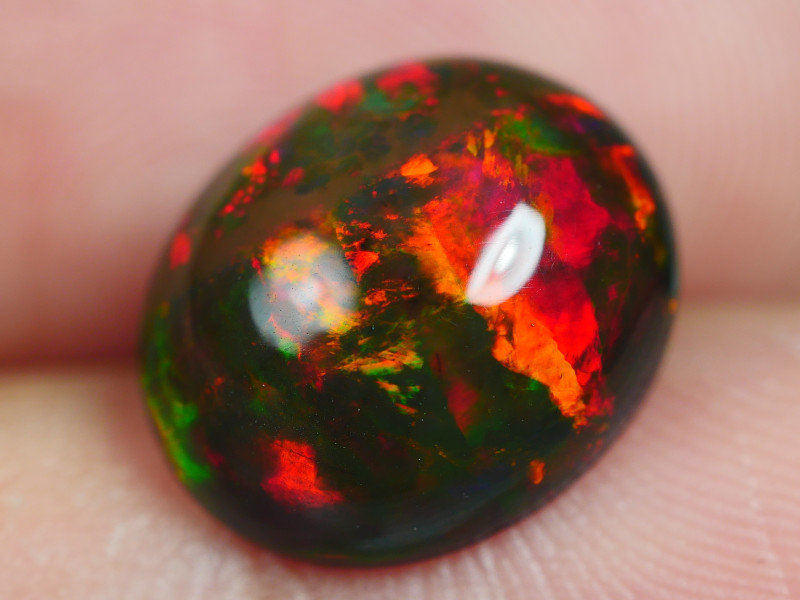
Un discreto numero di opali etiopi è stato trattato. Oltre ai trattamenti di riempimento di base per ridurre le screpolature, le tre tecniche principali sono la sbiancatura con zucchero e acido, l'affumicatura e la tintura.
Un trattamento acido-zucchero prevede l'immersione dell'opale in acqua zuccherata e poi in acido solforico. Il risultato è una serie di macchie e puntini sulla superficie che scuriscono la tonalità del corpo, aumentando così la luminosità del gioco di colori.
Il trattamento con fumo produce risultati simili. Questo processo richiede di avvolgere l'opale nella carta, riscaldarlo in un contenitore chiuso, quindi raffreddarlo e lavarlo. Gli opali idrofani tollerano bene i trattamenti con fumo, ma questo li rende più difficili da individuare.
La natura idrofanica degli opali etiopi si presta bene anche alla tintura, come si può osservare comunemente sugli opali etiopi viola o rosa brillanti, poiché queste non si verificano in natura.
Colore

Gli opali etiopi possono essere bianchi, neri, blu, rossi, rosa, arancioni o marroni, a seconda della miniera. Gli opali cristallini incolori provengono dalla miniera di Wegel Tena.
Il tono della pietra non è così determinante per il valore dell'opale etiope come lo è, ad esempio, per gli opali neri. Il significato principale del colore della pietra è il suo effetto sulla luminosità e sui motivi della pietra.
Il colore degli opali etiopi dipende in parte dalla provincia di provenienza, una parte fondamentale della storia della pietra!
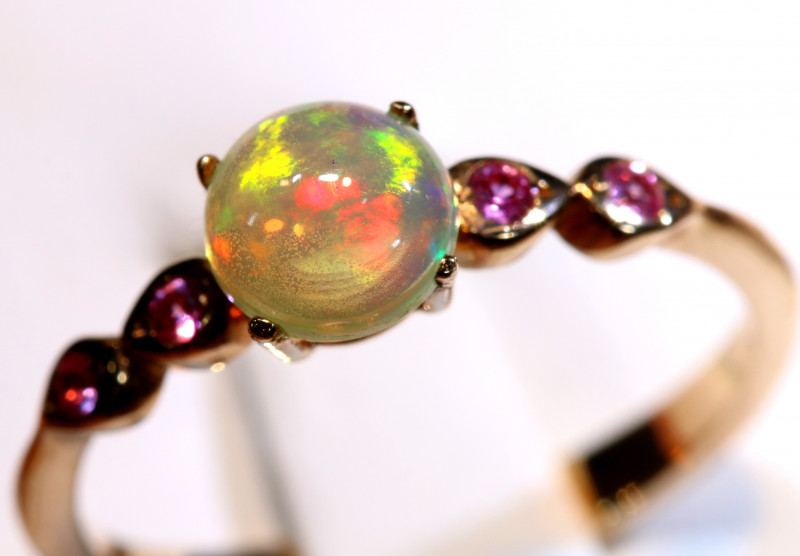
Storia dell'opale etiope
La scoperta moderna degli opali etiopi è avvenuta solo negli ultimi decenni. Tuttavia, gli opali più antichi rinvenuti in una grotta in Kenya, risalenti a circa 4000 a.C., erano probabilmente opali etiopi! Gli antropologi ritengono che i primi antenati dell'uomo usassero questi opali per realizzare utensili.
I nostri antenati preistorici, però, non li chiamavano "opali". Il nome "opale" deriva dall'antico sanscrito Upala , che significa "pietra preziosa", e dal greco successivo Opallios, che significa "vedere un cambiamento di colore".
Facciamo un salto al 1994: i minatori scoprirono il primo giacimento di opale etiope nella provincia di Shewa. Questi preziosi opali si trovavano all'interno di noduli di roccia vulcanica e avevano una colorazione marrone, bruno-rossastra o arancione. Sfortunatamente, erano anche soggetti a screpolature.
Nel 2008, i minatori scoprirono un secondo giacimento nella provincia di Wollo, vicino a Wegel Tena. Gli opali di Wegel Tena erano più resistenti degli opali Shewa e si presentavano in tipologie più attraenti, come opali bianchi, cristallo, fuoco e, occasionalmente, neri. "Opale Welo" divenne presto il nome commerciale per gli opali di questo giacimento.
È interessante notare che gli opali bianchi di Wegel Tena presentano un elevato contenuto di bario, talvolta accompagnato da inclusioni di pirite e carbonio. Alcuni esemplari presentano anche motivi a "digit", in cui strati di opale comune e prezioso creano giochi di colore in colonne simili a dita.
L'ultima importante scoperta risale al 2013, nella miniera di Stayish, sempre nella provincia di Wollo. Alcuni esemplari estratti erano di opale bianco o cristallo, ma la maggior parte era di opale nero o grigio scuro.
Oggi, il giacimento di Wegel Tena è noto per i suoi splendidi opali bianchi e cristallini, mentre la miniera di Stayish è nota per il suo opale nero.
Il gioco di colori dell'opale etiope è generalmente più intenso di quello dell'opale australiano, e i tunnel orizzontali rendono l'estrazione più facile rispetto ai pozzi verticali. I minatori etiopi hanno già estratto oltre 1.500 kg (3.300 libbre) di opale etiope grezzo!
Geologia a parte, cosa significa l'opale a livello spirituale?
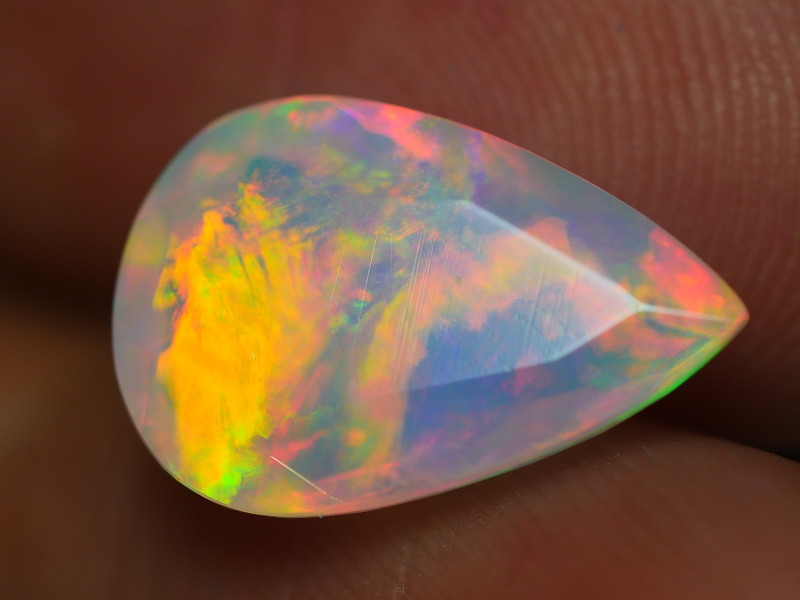
Significato e simbolismo dell'opale etiope
Come altre pietre preziose di opale , l'opale etiope simboleggia speranza, fortuna e innocenza. Inoltre, queste pietre rappresentano entusiasmo e creatività.
Che dire del significato dell'opale di fuoco etiope?
Gli opali di fuoco simboleggiano passione, calore e amore. Rappresentano una profonda guarigione emotiva e la fiducia che tutto accada per una ragione. Quando vengono regalate, queste pietre sono simbolo di lealtà e amicizia.
Provenienti dall'Etiopia, queste gemme vantano già una ricca storia culturale. Chiamata la "terra delle origini", l'Etiopia è il luogo in cui vissero i primi esseri umani, dove nacque il primo caffè ed è l'unica nazione africana con un proprio sistema di scrittura.
Anche altre culture hanno adottato i propri significati spirituali legati all'opale etiope. Il folklore arabo narra di opali che scendevano dal cielo attraverso i fulmini, mentre gli Aztechi usavano gli opali per proteggersi da maledizioni come il malocchio.
Quali sono oggi le proprietà mistiche dell'opale?
A cosa servono gli opali etiopi?
Le proprietà fisiche dell'opale etiope sono simili a molte delle sue proprietà curative, in particolare nella sua composizione idrofanica e nei suoi riflessi di colore.
Proprio come gli opali idrofani assorbono l'acqua, possono aiutare a combattere disidratazione, ritenzione idrica e affaticamento. Si dice che queste pietre possano anche migliorare la salute di occhi, capelli e pelle!
Dal punto di vista emotivo, l'opale etiope è benefico per chiunque lotti contro l'indecisione, la comunicazione o il pessimismo. I vivaci colori della pietra ricordano di accettare i propri punti di forza, di lasciar andare la negatività e di perseguire iniziative creative.
Il lato spirituale dell'opale etiope è illuminante, con proprietà purificanti che possono aiutare a sentirsi più appagati. Un'affermazione dell'opale etiope su cui meditare è: "Sono purificato dal passato e pronto per il futuro".
Chakra dell'opale etiope
Per la guarigione dei chakra, l'opale etiope si collega al chakra della corona. Situato sopra la testa, questo chakra governa l'autorealizzazione e la spiritualità.
Quando la corona è bloccata, potresti sentirti instabile o resistente alla crescita. L'opale etiope può aprire il chakra, portando saggezza e connessione spirituale con l'universo.
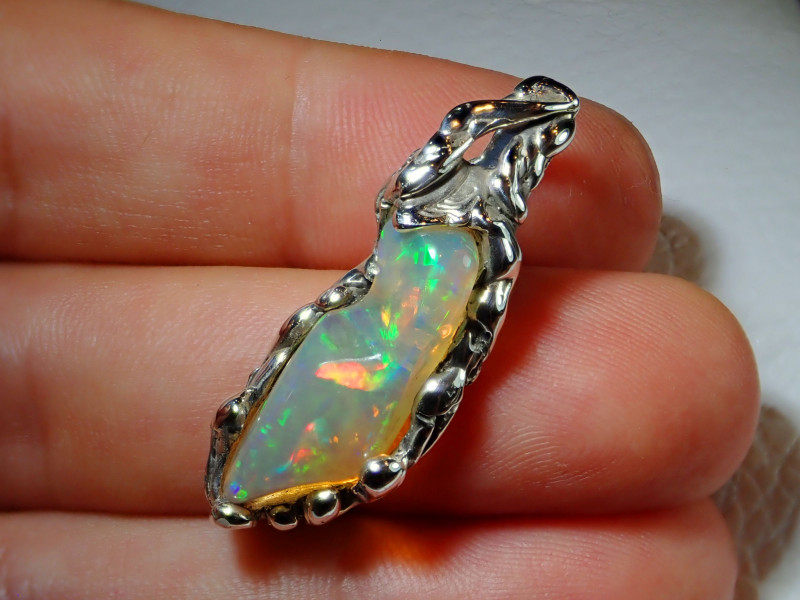
Affascinato dall'opale etiope?
Che tu preferisca l'opale nero, bianco o di fuoco, puoi trovare tutto ciò che desideri e molto di più nell'opale etiope. Data la sua ricca storia e le sue proprietà curative, indossare un anello in opale etiope è il modo perfetto per festeggiare il tuo compleanno a ottobre o semplicemente per sfoggiare il tuo stile unico!
Cerca il Opal Encyclopedia
Aste correlate
articoli Correlati
Tabella di conversione per le misure degli anelli
17th Jul 2018
L'opale Boulder è uno degli opali più sottovalutati sul mercato. Scopri di più su questo opale unico e scopri le splendide pietre che abbiamo in vendita.
29th May 2019
Con la passione per gli opali, Wayne ed Estella Sedawie hanno fondato Opal Plus più di 14 anni fa e hanno scoperto che internet è uno strumento prezioso. È qui che avviene la maggior parte delle transazioni internazionali dell'azienda.
17th Oct 2018
Articoli Recenti
Gli opali neri sono la varietà di opale più ricercata, con basi profonde che conferiscono un arcobaleno di riflessi alla superficie. Scopri gli usi, le proprietà, la storia e il valore degli opali neri!
7th Dec 2025
Scopri come vengono classificati gli opali e quali fattori ne influenzano il prezzo. Dal colore alla brillantezza, dal taglio all'origine, scopri come viene valutato ogni tipo di opale, con esempi di fasce di prezzo.
19th Jul 2023
Venite a scoprire il potere curativo degli opali con la nostra scrittrice ospite Vivien Schapera di Crystal Healing Techniques!
20th May 2023
Categorie di articoli
All there is to know about Opals including Black Opals, Ethiopian Opals & Boulder Opal
14 Articoli
Check out our fascinating information and articles on all things amazing in the Opal world
41 Articoli
Opal Auctions sellers who are approved as opal Verified Sellers
4 Articoli





